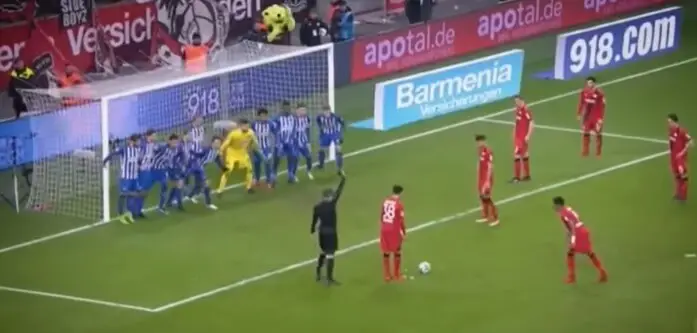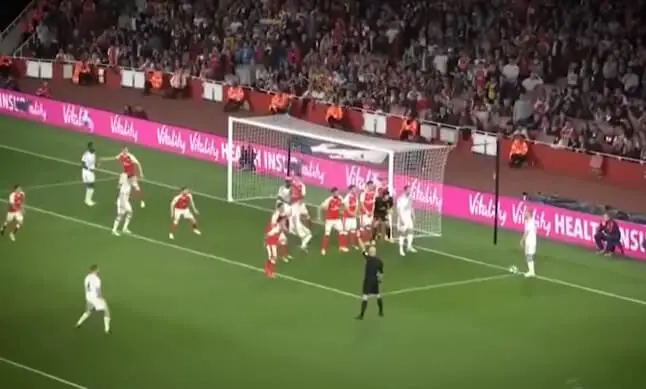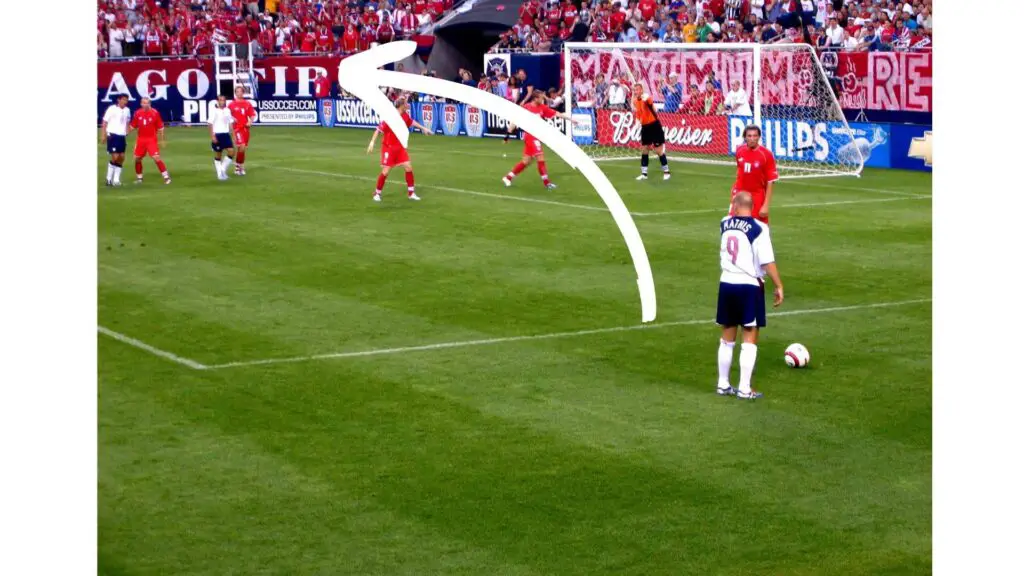In the exciting world of soccer, where a single free kick can make all the difference in the game’s outcome, it’s important to understand indirect free kick rules.
Amid the array of free kicks, the indirect free kick shines as a tactical gem, demanding a delicate fusion of precision and teamwork.
In this post, we’ll dive into the nitty-gritty details of indirect free kicks. You’ll learn the rules around these quirky restarts, the tactics teams use to maximize their chances, and some of the most creative indirect free kick goals ever scored.
Whether you’re a soccer novice or a hardcore fan, you’ll gain a deeper understanding of this unique aspect of the beautiful game.
Let’s kick things off!
Table Of Contents
- What Exactly is an Indirect Free Kick?
- Indirect Free Kick Rules in Soccer
- Where Can Indirect Free Kicks Be Awarded?
- Indirect Free Kick in the Box
- 4 Key Strategies for Scoring from Indirect Free Kicks
- The Most Creative Indirect Free Kick Goals
- The Controversies Around Indirect Free Kicks
- Appreciating the Art of the Indirect Free Kick
- Final Word
What Exactly is an Indirect Free Kick?
FIFA’s Law 13 defines an indirect free kick as a kick awarded to the opposing team after a player commits a non-penal foul or infringement. Unlike direct free kicks, a goal cannot be scored directly from an indirect free kick. This means a player must touch the ball before it enters the goal in order for the goal to count.
Indirect Free Kick Rules in Soccer

When the referee signals for an indirect free kick, a unique set of rules and behaviours comes into play. Unlike a direct free kick where a goal can be scored directly from the kick, an indirect free kick requires a few additional steps.
Here’s a breakdown of how players behave and what they must do during an indirect free kick:
1. No Direct Shots
The most significant difference is that players cannot score directly from the kick. The ball must touch another player before a goal can be scored. This means the player taking the kick cannot kick the ball straight into the goal without it touching someone else first.
2. The Two-Touch Rule
The player taking the indirect free kick cannot touch the ball again until another player has touched it. This is why you often see a quick pass before the initial kick to goals.
3. Opponent Distance
Before the kick is taken, all players from the opposing team must be at least 10 yards (about 9 meters) away from the ball. This gives the attacking team space to take the kick and pass the ball without interference.
4. Ball In Play
The ball must be kicked and moved in order for it to be considered “in play.” This is why the second player’s touch is crucial; it officially starts the game action after the kick.
5. Pass Back Rule (Goalkeeper Position)
The goalkeeper must also follow the rule of not touching the ball with their hands if it’s deliberately passed to them by a teammate with the foot.
If they do, an indirect free kick is awarded to the opposing team from the spot where the offense occurred.
6. Defending the Kick
The defending team often sets up a “wall” of players between the ball and the goal to block the attacking team’s shot. However, the wall cannot come closer than 10 yards from the ball until it’s kicked.
7. Referee Signals
The referee signals for an indirect free kick by raising their arm. This signals to players that the kick is indirect and no direct shots are allowed.
The most common examples of infringements leading to indirect free kicks include:
- The goalkeeper picking the ball with their hands after receiving a pass from a teammate.
- Dangerous play
- Obstruction
- Offsides
- Dissent
- Goalkeeper infractions like holding the ball for more than 6 seconds
When an indirect free kick is awarded, the referee will indicate it by raising his arm straight above his head. He will keep his arm raised until the second touch on the ball is made or the kick goes out of play.
This crucial signal alerts everyone that a shot cannot be taken directly on goal.
Where Can Indirect Free Kicks Be Awarded?
Indirect free kicks are awarded from the spot where the infringement took place. The only exception is for offside offenses, where the kick is given from the location where the offending player was when the ball was played forward.
So if a goalkeeper holds onto the ball for too long, the indirect free kick will be taken right from the six-yard box. But if a player is whistled for obstruction halfway between the midfield line and the penalty area, that’s where the restart will occur.
Indirect Free Kick in the Box
Ever seen those tricky moments in soccer when the attacking team gets a free kick inside the opponent’s penalty box, but they can’t just shoot directly?
That’s what we call an “indirect free kick in the penalty box.” It’s like a puzzle in a game, where certain rules make things interesting.

Why Does This Happen?
Here’s the scoop: When a goalkeeper grabs the ball after a teammate passes it with their feet, a special rule kicks in.
Instead of giving the attacking team a regular free shot, they get an indirect free kick inside the box. This rule is there so everyone keeps playing fair and the game doesn’t slow down.
When Does It Happen?
Imagine this: the goalkeeper is under pressure, and they pick up a pass from a teammate inside the penalty box. That’s when the magic begins. The other team gets a chance to show their skills.
But there’s a catch—before the ball goes into the net, it has to touch another player.
So, it’s like a secret code that needs to be cracked.
How Does the Action Unfold?
It’s a bit like a dance move. The attacking team has to figure out how to tap or pass the ball so that a teammate touches it before it scores.
The defenders, on the other hand, form a human wall to block the shot. It’s like a mini battle on the field, where everyone has a role to play.
4 Key Strategies for Scoring from Indirect Free Kicks
Executing an indirect free kick well requires precision, creativity, and the element of surprise. Here are 4 tactics and tricks teams use to catch opponents off guard and net a goal from these restarts:
1. Close-Range Quick Pass
If an indirect free kick is awarded near the 18-yard box, a team’s best bet is often a rapid-fire pass to a teammate.
The player taking the kick taps the ball to a teammate lurking close by, who can then one-time it into the net before the defense reacts.
This indirect free kick is seen every day in games.
2. Chip to the Far Post

For indirect free kicks farther from the goal, teams often chip the ball over the wall to a player attacking the far post.
The player taking the kick lofts it up and over the defenders, allowing a teammate to run onto the ball and head or volley it home.
Teams use it often in games.
3. Shot Off the Wall
Another common ploy is to take a full-powered shot that deflects off the wall and falls to another attacker for the finish.
The massed defenders often form a wall to block direct shots, but this can work against them by creating a ricochet.
Gareth Bale of Real Madrid did this accidentally in a 2018 match versus Celta Vigo, with the ball rebounding perfectly for a Karim Benzema goal.
4. Double Dummy Run
One of the trickiest indirect free kick routines involves using two decoy runners.
Two teammates make angled runs like they are going to receive the pass, causing defenders to follow. But the kick-taker actually plays the ball backwards or through a defender’s legs to a trailing player coming straight on for the shot.
Tottenham executed this brilliantly in a 2015 Europa League match, with Christian Eriksen wrong-footing the defense to set up Harry Kane.
The Most Creative Indirect Free Kick Goals
Over the years, there have been some insanely inventive goals scored from indirect free kicks. Let’s look at one of the most creative ever:
Ferenc Puskás – Real Madrid vs Barcelona, 1960: In a match between arch-rivals Real Madrid and Barcelona in 1960, Ferenc Puskás scored an indirect free-kick goal from inside the penalty box.
The Barcelona goalkeeper, Antoni Ramallets, picked up a back-pass from a teammate, leading to an indirect free-kick for Real Madrid.
With the Barcelona players forming a wall on the goal line, Puskás rolled the ball to his teammate, who touched it back to Puskás.
Puskás then smashed the ball into the net, and it deflected off a Barcelona player before crossing the goal line.
This unique indirect free-kick goal showcased the precision and creativity of Puskás and his teammates.
You can watch more indirect free-kick goals here.
The Controversies Around Indirect Free Kicks
The nuanced rules around indirect free kicks have led to plenty of controversies over the years. Referees must make tricky judgment calls on when and where to award indirect free kicks.
There have also been many instances of players acting confused by the referees’ signals, resulting in cheap goals being allowed to stand.
In the modern game, Video Assistant Referee (VAR) can be used to review refereeing decisions and clarify any confusion over indirect free kicks.
But before VAR, many goals were allowed or disallowed amid furious disputes over indirect free-kick signals.
These controversies reflect how deeply the indirect free kick is woven into soccer’s fabric.
While maddening at times, the complexities surrounding indirect free kicks force players to show creativity and skill.
Appreciating the Art of the Indirect Free Kick
Once you understand the rules and strategies around indirect free kicks, you gain a whole new appreciation for them. What may seem like a fluke or unjust goal at first glance takes on layers of difficulty and brilliance.
From the audacious trick goals to innovative tactics like the double dummy run, indirect free kicks showcase soccer artistry at its finest.
The next time you see an indirect free kick awarded, watch closely for the exquisite interplay between the kick-taker, runners, and finishers trying to unlock the defense.
Final Word
The intricacies of the beautiful game reveal themselves in these unique restarts.
As a fan, keep your eye out for indirect free-kick goals that will leave you marvelling at the creativity on display. You may just witness a stunning goal from an unexpected source thanks to soccer’s most misunderstood rule.
This article was all about soccer indirect Free Kick rules and strategies to take it. Hope you have gained value from it.
You might also like these articles:

